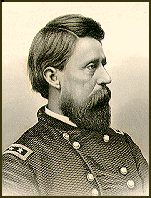|
Jefferson Columbus Davis
Commander, Military District of Alaska
Jefferson Columbus Davis, born 2 March 1827, Clark County,
Indiana, was the first of eight children born to William
Davis, Jr. (1800-1879) and Mary Drummond (1801-1881). He
grew up in the Charleston area of Clark County on his
father's farm. Around 1860 he married Marietta Woodson Athon of Indianapolis, a daughter of Dr. James S. Athon
(1811-1875). They had no children, but adopted and raised
a niece, Ida Davis.
 Davis was a career officer in the United States Army
(1848-1879) Davis was a career officer in the United States Army
(1848-1879)
For his performance t
the age of 20, Davis was given a direct commission
On April 12, 1861, Davis was stationed at Fort Sumter,
Charleston, South Carolina, when the Confederates started
their 36-hour bombardment.
On August 17, the 22nd Indiana was sent to seek out the
Confederates in the interior of Missouri.contributed
heavily toward a Union victory
It was in September 1862 that Davis's
career passed a crisis point. He and his superior officer,
William "Bull" Nelson, were at the Galt House hotel in
Louisville, Kentucky, exchanging insults. The provoked
Davis, at five feet, nine inches and 125 pounds, blatantly
shot and instantly killed ("in cold blood") the
six-foot-four, 300-pound Nelson. Davis was never tried for
this offense as politically powerful Governor Oliver P.
Morton of Indiana quickly came to his defense.
(Murfreesboro), TennesseeHe was exemplary at
Chickamauga, Georgia, in September 1863. During the
Atlanta campaign, Davis especially distinguished himself
in the capture of Rome, Georgia, and in his successful
attack at the battle of Jonesborough. He commanded the
Fourteenth Corps in the march to the sea and the Carolinas
campaign.
Davis was never received the second star of a major
general although he received five brevet commissions.
The Alaskan assignment was not
a choice one.
Edward Richard Sprigg
Brevet Major General Davisin
Crown Hill Cemetery in Indianapolis, Indiana.

Sources:
Boatner, Mark M., The Civil War Dictionary, p.
222.
Dictionary of American Biography, Vol. III, p.
131.
Dunn, Jacob Piatt, Indiana and Indianians, Vol.
IV, pp. 1563-4.
Faust, P. L. , ed., Encyclopedia of the Civil War,
p. 207-8.
Hughes Jr.,
Nathaniel Cheairs and Gordon D. Whitney, Jefferson Davis in Blue: The Life of Sherman's
Relentless Warrior.
Baton Rouge:
Louisiana State University Press, 2002.
Sifakis, Stewart, Who Was Who in the Civil War,
pp. 172-3.
Twentieth Century
Biographical Dictionary of Notable Americans: Volume III,
p. 164.
|